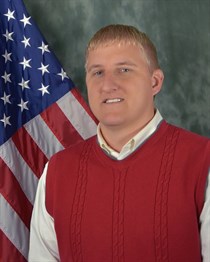 Dr. Darren Hartl, TEES Research Assistant Professor at Texas A&M University, and a team of researchers is using extensive data on avian biological systems in the hopes of creating unmanned aircraft with wings that morph and change during flight, much like a bird.
Dr. Darren Hartl, TEES Research Assistant Professor at Texas A&M University, and a team of researchers is using extensive data on avian biological systems in the hopes of creating unmanned aircraft with wings that morph and change during flight, much like a bird.
A five-year, $6 million grant sponsored by the Air Force Office of Scientific Research teams, Hartl with engineering researchers from the University of Michigan, Stanford, and UCLA in hopes of dramatically transforming aerodynamic performance. Dr. Daniel Inman, chair of the Department of Aerospace Engineering at the University of Michigan, will serve as the Principal Investigator for the project.
By delving deeper into avian neurology and musculature, the team hopes to create unprecedented efficiency and flight longevity in small aircraft and UAVs. To this end, the team will work closely with bird biologists from the United Kingdom’s Royal Veterinary College, the University of British Columbia and Stanford to closely examine the complex systems birds use to alter their wings for flight control. Research will delve into multiple aspects of bird flight: control, aerodynamics, structure and adaptive structures, looking at the muscular-skeletal structures and how bird wings move and adapt in flight.
Although previously studied morphing wings have been inspired by avian biology, the grant will be the first to examine the biological systems in such depth. Modern airplanes use drag-inducing flaps and slats for control, but birds manipulate individual feathers or clusters of feathers on their wings, adjusting them to create a fluidly morphing, reduced-drag surface suited to their needs. It has long been a goal to recreate such a flight system, and cutting-edge technology has been developed to examine these mechanisms of flight.
 Extending the paradigm of the “muscular-skeletal” structure of birds, the grant will also focus on using distributed multifunctional materials to drive morphing. Hartl will leverage years of experience in shape memory alloy (SMA) aerospace actuators to develop new “muscular” architectures, focusing on the active material that could be used to affect the morphing. Henry Sodano (University of Michigan) will explore new piezoelectric material forms and functions. Piezoelectric materials generally move at higher speeds with lower strengths and smaller motions, while SMAs are slower and have higher strength and larger motions. Both systems will be needed depending on whether the wing needs to morph slowly versus when it needs to move quickly.
Extending the paradigm of the “muscular-skeletal” structure of birds, the grant will also focus on using distributed multifunctional materials to drive morphing. Hartl will leverage years of experience in shape memory alloy (SMA) aerospace actuators to develop new “muscular” architectures, focusing on the active material that could be used to affect the morphing. Henry Sodano (University of Michigan) will explore new piezoelectric material forms and functions. Piezoelectric materials generally move at higher speeds with lower strengths and smaller motions, while SMAs are slower and have higher strength and larger motions. Both systems will be needed depending on whether the wing needs to morph slowly versus when it needs to move quickly.
New distributed sensing systems (Fu-Kuo Chen of Stanford) and neuromorphic computation for control (Yong Chen of UCLA) will also be part of the discovery and implementation process. A parallel effort on bio-inspired evolutionary structural design approaches has also been initiated within the Air Vehicles Division of the Aerospace Systems Directorate at the US Air Force Research Laboratory, where Hartl also holds a position as a contracted research scientist.
“It used to be that a biologist would just go out in the field with a pair of binoculars,” said Inman, “but the technology has advanced drastically in recent years.”
Hartl added, “We plan to go far beyond simple qualitative imitation; we will quantify effects at the platform scale and muscular-skeletal configurations at the structural scale to develop new solutions to the morphing aircraft problem.”
While Inman works on the whole bird, or the plane, Hartl will drill down into the bone and muscle and focus on the structure of the wing, particularly the parts needed to move the structures.
Using new kinematics and dynamics data from avian researchers, the engineering team aims to make small airplanes and UAVs lighter, faster and more efficient, enabling longer flights. Drawing on bird biology and recent advancements in active materials, the team will research a morphing wing structure with distributed actuation and sensing that is capable of independent deflections throughout the wing.
Hartl will start with ideas that are bio-inspired, including looking at novel energy circuits for active material actuation, much akin to the supply of energy via the bloodstream to the muscles in birds.
“We’re looking at supplying electrical energy to shape memory alloy muscles using liquid metals, and then using that same liquid metal to flow the waste heat away,” said Hartl. “We’ll start researching that concept as we await the quantitative data corresponding to observation of the birds.”
Research will officially begin with a meeting in Ann Arbor, Michigan on May 13. Hartl’s research begins in the fall when he joins the Department of Aerospace Engineering at Texas A&M as a tenure-track assistant professor.
His team at Texas A&M will include two graduate students and three undergraduate students. Hartl is in the process of building a dedicated space for the project, including a new experimental wind tunnel test section in the basement of the H.R. Bright Building on the Texas A&M campus. The test section will allow the team to test the muscular solutions with some kind of wing-type structures before integrating them with testing to be done at Michigan.
Ultimately the team of collaborators hopes to create a new morphing wing structure capable of dramatically altering aerodynamic performance, allowing for planes that should be lighter, faster and dramatically more maneuverable than today’s stiff-winged aircraft.